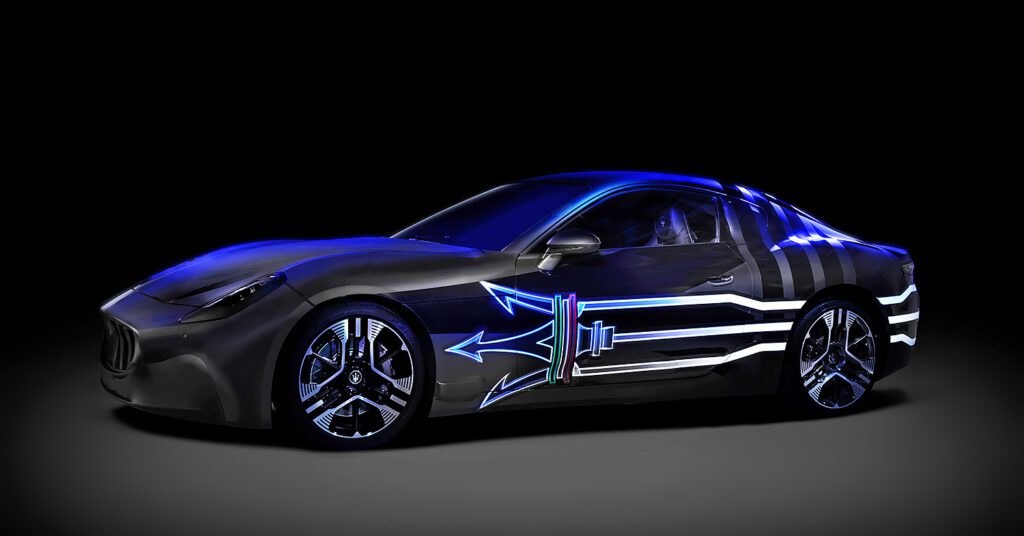Maserati is bidding adieu to gas-guzzling engines and rolling towards an all-electric future.
The Italian luxury car brand has announced the launch of an entirely electric range, called Maserati Folgore. By 2025, the company plans to offer electric versions of every model in its lineup.
Maserati’s first EV in the range will be its new GranTurismo. The car will feature 1,200 horsepower and is set to debut in 2023. Up next, the company will release an all-electric Grecale SUV and GranCabrio GT convertible, followed by electric versions of the MC20 “super sports car,” the Quattroporte sport sedan, and the Levante SUV.
Moreover, the brand—which is owned by multinational automotive manufacturing corporation Stellantis—revealed that by 2030, all new cars developed by the company will be fully electric.
“Maserati stands for performance and luxury, and that will be protected for sure in the future,” said Maserati’s CEO Davide Grasso. “As we move toward electrification, you will see more dedicated architecture focused on delivering the best in range and performance.”

Maserati goes electric, but at what cost?
Maserati joins a number of other luxury carmakers in ditching fossil fuels, including Bentley, Audi, and Mercedes-Benz.
The move to go all-electric is a “defining moment” for the 107-year-old brand, noted Grasso. It’s also part of the company’s revamp, which was unveiled in September 2020 at its “MMXX: Time to be Audacious” event at the Modena Circuit race track in Italy.
In addition to widespread electrification, Maserati’s relaunch, which has been in the works since 2018, includes an update of its iconic Trident logo, now ”more modern, balanced and elegant.” “We’re proud to inaugurate our new Era,” explained Grasso. “For our Brand, this is a time to build: the time to be forward-looking and construct our future.”
While Maserati’s plans to electrify its entire range are a step forward in terms of mitigating the transportation sector’s leading role in climate change, it’s hard to ignore the brand’s high price tag. A 2022 GranTurismo coupe runs about $300,000. Tack on an extra $35,000 for the new GranCabrio. While information is limited about the release, the starting price for Maserati’s first electric car is also expected to be in the six figures.
Prohibitive cost is one downside to electric vehicles. In recent years, the likes of Tesla have become status symbols for the elite, rather than clean-fuel solutions. On the low end, a 2022 Tesla Model 3 goes for about $45,000. And on the high end, a new Tesla Model X runs about $105,000. Other luxury electric vehicles are just as pricey. The MSRP for a new Porsche Taycan starts at $82,700; a BMW iX starts at $83,200. Even non-luxury electric vehicles like the Polestar 2, which starts at $45,900, typically feature high price tags. Put simply, they’re inaccessible to most consumers. In order to expand accessibility, the private sector and the government must increase incentives and tax discounts. Without that, electric vehicles will likely remain out-of-reach for the average person.
But, the fact that more countries are pledging to achieve carbon-neutrality by 2050 has resulted in an uptick of car manufacturers like Volvo, Ford Europe, and Honda going all-electric. And as the electric vehicle market broadens and sales volumes surge, conversely, the production costs of electric cars will eventually go down. (For example, the 2022 Nissan Leaf starts at $28,425.)
Automotive experts predict that electric vehicles prices will drop and reach price parity with their gas-powered counterparts—perhaps even as soon as 2025. “On an upfront basis, these things will start to get cheaper and people will start to adopt them more as price parity gets closer,” said Colin McKerracher, BloombergNEF’s Head of Advanced Transport. Overall, the shift towards electric vehicles is a good thing, so long as it remains equitable.


